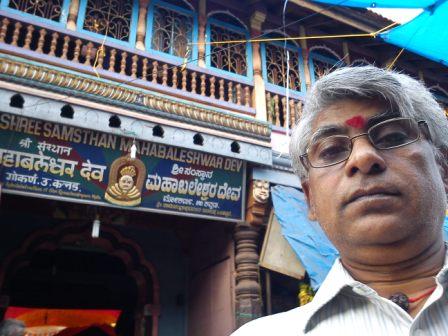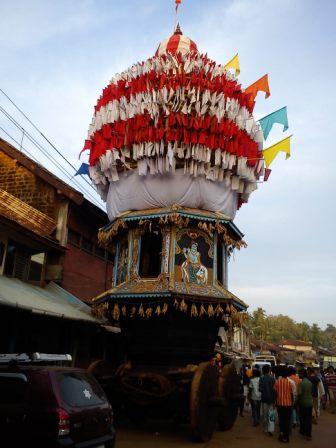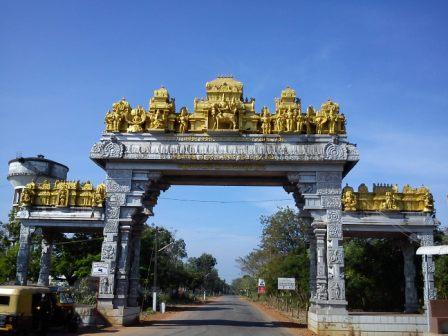20, December 2011.
To add to
my list of Paadal Petra Shiva Sthalangal darshan I planned to go
to the Tulu Nadu (Karnataka) Paadal Petra petra sthalam. When
I discussed this with friends, everybody suggested adding more temples during this
visit. Murudeshwar, Udupi, and Dharmasthala are the temples that were added to
the list of my yatra. One of my best friends Mr C K Namdev helped me a
lot and arranged for accommodation at Gokarna and Udupi.
I cannot forget the hospitality extended to me by his daughter during the stay
at Gokarna. I was honored that they dined along with me and they even skipped
the usual non-vegetarian seafood, since I am a strict vegetarian (Now !!!).
The
yatra went like this......
After
reaching Mangalore at 4.25 Hrs on 17-12-2011 ,
boarded the Mangalore Verna Passenger train to Gokarna (225 km)
starting at 06.50 Hrs. On seeing the Murudeshwar Temple Gopuram and Shiva statue
from a long distance got down at Murudeshwar station and went to
temple, through auto from the main road. The auto driver charged me
only Rs 20, which was a surprise to me. Shiva statue is the second tallest in
the world (123 feet, 1st is at Nepal
After
having a darshan at Murudeshwar came to the main road to catch the bus to Gokarna.
Since there is no straight bus to Gokarna went through Kumta. In
Gokarna temple did pooja to Mahabaleshwar as directed by the priest and was able to
touch and feel the Shiva statue of very very small size (
Kottai pakku ). The fee paid to the temple was Rs 150.00. The temple
is constructed in a unique Kerala style with wood and
Mangalore tiles without Rajagopuram. Amman
After the
darshan of Mahabaleshwar, left for UDUPI at about 16.45 Hrs via Kumta by bus after
thanking Mr. Namdev’s daughter and his son-in-law. Arrived Udupi at 00.30 Hrs on 18-12-2011 and
went to the lodge Mallika. The room was reserved by Mr Namdev’s
brother-in-law Mr Ganesh. After having sleep
of just 3 hours went to Udupi Temple
From
Udupi, there are no frequent buses. Got the bus at 09.00 Hrs and it took nearly
3 hours and 15 minutes to reach the Dharmasthala temple (110 Km through the hill
route. The roads in many places are very bad. Since the day Sunday, happened to
be a weekly holiday, the very heavy rush was there. It took me about 30
minutes to deposit my Chappel and back bag. Got a Rs 200 ticket and moved
through a very very long QQQQQQQ and had the darshan of Sri
Manjunatha Swamy and Ammavaru. After darshan came out at 13.00 Hrs and boarded
the bus (Near the temple entrance) to Mangalore to catch the Chennai super
fast Express Train which leaves at 16.00 Hrs. I was a little upset for
not being able to spend more time seeing the Bahubali statue and other places, and importantly missed the free meals as everybody suggested. When I reached the
station the time was 15.45 Hrs and announcement call to board the
train.
The total distance covered in the yatra is 2500 Km in 72 hours (16th 09.00 hrs from Chennai Home and reached on19th Dec
2011 at 09.00 Hrs) of which Darshan time in
the temples was around 7 to 8 hours only.
GOKARNA AND MURUDESHWAR
The total distance covered in the yatra is 2500 Km in 72 hours (16th 09.00 hrs from Chennai Home and reached on
GOKARNA AND MURUDESHWAR
(The history is taken from the Wikipedia website). The origin of the name "Murudeshwara" dates to the time of Ramayana. The
Hindu gods attained immortality and invincibility by worshipping a divine Lingam called
the Atma-Linga. The Lanka King Ravana wanted
to attain immortality by obtaining the Atma-Linga (Soul of Shiva). Since
the Atma-Linga belonged to Lord Shiva, Ravana worshipped Shiva with
devotion. Pleased by his prayers, Lord Shiva appeared before him and asked him
what he wanted. By this time Narada had asked Lord Vishnu to
change Ravana's mind. As a result of this plot, Ravana asks for Goddess Parvati, and Lord
Shiva offers her to him. On his way back to Lanka Narada tells Ravana that Lord
had not given him the real Parvathi and that the real Parvathi was in Pathala.
So Ravana frees his companion, goes to Pathala, and marries a king's daughter,
assuming her to be the real Parvathi. He then returns to Lanka, where his
mother asks him for the Linga. Ravana then comes to know of the tricks played
on him by Lord Vishnu. He therefore prays to Lord Shiva again, begging for his
forgiveness. Lord Shiva appears and this time, Ravana requests
the AtmaLinga as his boon. Lord Shiva agrees to give him the boon
with the condition that it should never be placed on the ground. If
the AtmaLinga was ever placed on the ground, all the powers would
return to Lord Shiva again. Having obtained his boon, Ravana started back on
his journey to Lanka.
Sage Narada, who came to know of this incident, realized that with
the AtmaLinga, Ravana may obtain immortality and create havoc on Earth. He
approached Lord Ganesh and requested him to prevent
the AtmaLinga from reaching Lanka. Lord Ganesh knew
that Ravana was a very devoted person who used to perform prayer rituals in the
evening every day without fail. He decided to make use of this fact and came up
with a plan to confiscate the AtmaLinga from Ravana.
As Ravana was nearing Gokarna,
Lord Vishnu blotted out the sun to give the appearance of dusk through his Sri chakra. Ravana now had to perform his evening rituals but was worried
because, with the AtmaLinga in his hands, he would not be able to do
his rituals. At this time, Lord Ganesh in the disguise of a Brahmin boy
accosted him. Ravana requested him to hold the AtmaLinga until he
performed his rituals, and asked him not to place it on the ground. Ganesh
struck a deal with him saying that he would call Ravana thrice, and if Ravana
did not return within that time, he would place the AtmaLinga on the
ground.
267. SRI MAHABALESHWAR TEMPLE,
267. SRI MAHABALESHWAR TEMPLE,
GOKARNA - THIRUKOKARNAM
Now, this place is called Gokarna. It is the 267th Paadal Petra Shiva Sthalam, the only sthalam in Thuluva Nadu on the seashore. Thirugnanasambandar and Appar have sung hymns in praise of Lord Shiva, who is worshipped in this temple.
Sri Aathma lingeswarar
Consort : Sri Gokarneswari, Sri Thamragowri
Some of the important features of this temple are…
The temple architecture is similar to Kerala-style architecture with wood and Mangalore tiles. Moolavar is facing west and there are entrances on the south and west side. Ambal is facing east, in a separate sannadhi. Moolavar is very small and can be touched through a hole like avudayar below the ground level. Devotees can do abhishekam and pooja to the moolavar through their own hands.
Consort : Sri Gokarneswari, Sri Thamragowri
Some of the important features of this temple are…
The temple architecture is similar to Kerala-style architecture with wood and Mangalore tiles. Moolavar is facing west and there are entrances on the south and west side. Ambal is facing east, in a separate sannadhi. Moolavar is very small and can be touched through a hole like avudayar below the ground level. Devotees can do abhishekam and pooja to the moolavar through their own hands.
Sannadhi for Thathreyar and Adi Gokarneswara, Vinayagar, and Mahisasura Marthini. The Vinayagar sannidhi is on the east side of the temple, and Ravana's hit left him with a scar on his head.
Brahma,
Agasthiyar, Kamadhenu, Markandeyar, Saraswathy, Vasistar, Ravanan, and Nagarajan worshiped lord Shiva of this temple.
HOW
TO REACH :
Gokarna
is on the train route from Mangalore to Goa and about 5 km from the Railway station.
Buses are available from Udupi and Mangalore.
CONTACT DETAILS:
The
temple website: CLICK HERE
Contact: Administrator,
Shri Samsthana Mahabala Deva,
Post: Gokarna, U.K,Karnataka
Phone: +91
9482331354 / 08386-257956
E-Mail: info@srigokarna.org
LOCATION OF THE TEMPLE: CLICK HERE
Contact: Administrator,
Shri Samsthana Mahabala Deva,
Post: Gokarna, U.K,Karnataka
Phone:
E-Mail: info@srigokarna.org
LOCATION OF THE TEMPLE: CLICK HERE
( Moolavar vimanam - View through shades )
( Side entrance of the moolavar sanctum )
( Vinayagar temple on the main temple street - Marks of Ravana's hit on the head)
( Aadhi Sankara's mandapam on the sea shore )
( A small temple on the hill )
( Temple car / Chariot )
The entrance arch of the Temple is about a KM on the main road - Opposite is the
Murudeshwar railway station - Built by Tamil sthapathy where the Temples name is
written in Tamil- Later learned that Mr. Ganapathi Sthapathi's Son in law had
done this project.

( Temple complex view )
( Entrance of the Rajagopuram )
Stucco sculptures under the basement - Ravana asks Brahmin boy (Vinayagar) to keep the Siva Lingam
Ravanan hit Vinayagar on head
( Ravanan tried to lift Shiva Lingam - Shiva lingam has become like cow's ear ( GOKARN )
SRI KRISHNA TEMPLE -
HISTORY: One of the popular stories goes like this. The main statue of Sri
Krishna at Dwaraka was completely covered by gopichandanam (holy sandalwood).
A sailor from Dwaraka loaded this heavy lump in his boat as ballast, in one of
his trips along the west coast. The ship was caught in a terrible storm while
sailing on the western coast of Malpe .
When the meditating Sri Madhvacharya sensed this by his 'aparoksha' or divine
gana thirushti (knowledge), he got the ship safely to the shore by waving the
end of his saffron robe and pacifying the storm. The pleased captain of
the ship offered Sri Madhvacharya anything on the ship in return. Sri
Madhvacharya asked for the sandalwood piece containing the statue of Sri
Krishna. Later as the story goes, Sri Madhvacharya took it to the lake,
purified it, and installed it in the mutt.
( Temple complex view with Temple Tank )
(Firewood chariot )
( Temple chariot )
( Rajagopuram in front of Kanaka Kindi statue )
( Temple entrance arch )
( Temple complex view )
( 5 tier Rajagopuram )
SRI MANJUNATHA SWAMY TEMPLE AT DHARMASTHALA
HISTORY: Initially
this place was a small village by the name of Kuduma in Mallarmadi and
was situated in Belthangady. In this village resided a Jain Bunt chieftain,
Birmanna Pergade, along with his wife, Ammu Ballalthi. The house they lived in
was known as Nelliadi Beedu.
Legends foretell that
the four guardian angels of Lord Dharma disguised themselves as human beings
and visited the chieftain’s house. They were searching for a place where Dharma
could be preached and it could be propagated and continued. The Pergade family
received them with due respect as is shown to visitors. The Dharma Daivas
were very pleased with the hospitality shown by Birmanna Pergade and
appeared in his dreams that night. The guardian angels informed the chieftain of the purpose of their visit and requested the Pergade couple to vacate
their house and follow the path of Dharma and also worship the Daivas. The
Pergade couple vacated the house at Nelliadi Beedu and built another house for
themselves. To date, the worship of the Dharma Daivas continues in this house.
Again the Dharma
Daivas appeared in the dreams of the chieftain and instructed him to build
separate shrines for the four Daivas. You will find that the Dharmasthala Manjunatha Temple has
four separate shrines dedicated to the four Dharma Daivas. Pergade was also
directed to choose two persons of noble descent who would act as the oracles of
the Dharma Daivas. Pergade chose four worthy persons who would assist him in
performing his duties as an Executive Head of the four shrines.
The Daivas promised
that the Pergade family would get abundant resources in the form of charity and
fame through the Kshetra. Brahman priests were invited to perform the
rituals after Pergade constructed these shrines. The priests requested Pergade
to also build a Shivalinga beside the Daivas. Annappa Swamy, the servant of
the Daivas, was subsequently sent to Kadri, near Mangalore, to procure a Shiva
Lingam. Shortly afterwards the Dharmasthala Manjunatha Temple was erected around
Shiva Linga.

























This comment has been removed by the author.
ReplyDeleteVery superb n informative for us sir,
ReplyDeleteThanks for the encouraging comments
ReplyDeletevery good post ameya jaywant narvekar
ReplyDeleteThanks a lot for visiting our blog and the encouraging comments
Delete